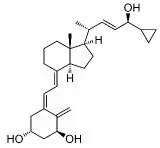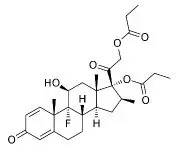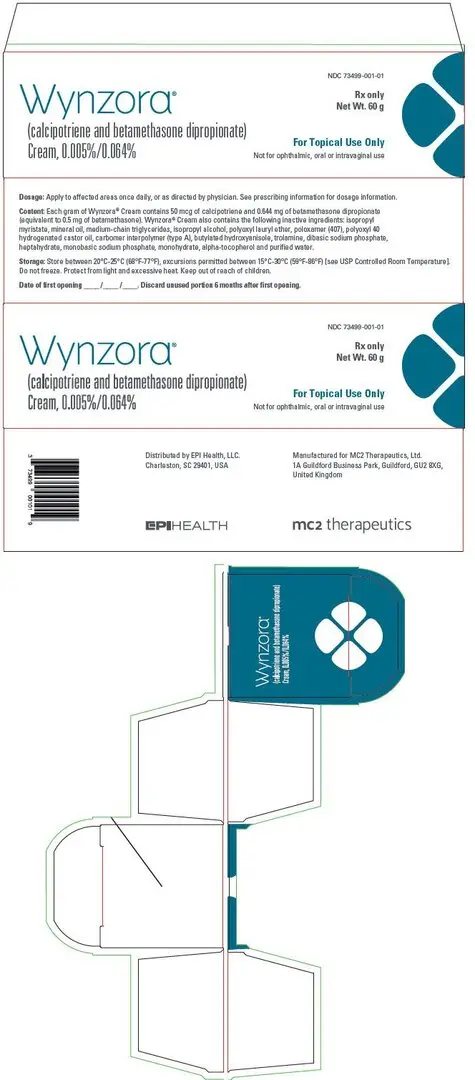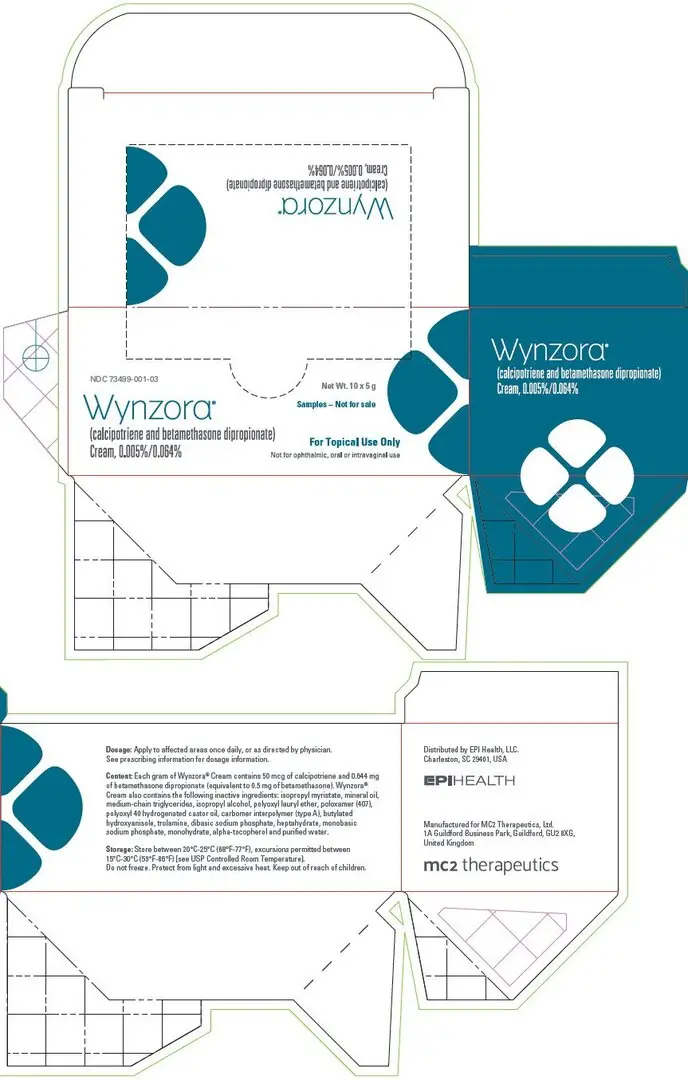Drug Detail:Wynzora (Calcipotriene and betamethasone dipropionate)
Drug Class: Topical antipsoriatics
Highlights of Prescribing Information
WYNZORA® (calcipotriene and betamethasone dipropionate) cream, for topical use
Initial U.S. Approval: 2020
Indications and Usage for Wynzora Cream
WYNZORA Cream is a combination of calcipotriene, a vitamin D analog, and betamethasone dipropionate, a corticosteroid, indicated for the topical treatment of plaque psoriasis in patients 18 years of age and older. (1)
Wynzora Cream Dosage and Administration
- Apply WYNZORA Cream to affected areas once daily for up to 8 weeks. (2)
- Discontinue therapy when control is achieved. (2)
- Do not use more than 100 g per week. (2)
- Do not use with occlusive dressings unless directed by a physician. (2)
- Avoid use on the face, groin, or axillae, or if skin atrophy is present at the treatment site. (2)
- Not for oral, ophthalmic, or intravaginal use. (2)
Dosage Forms and Strengths
Cream: 0.005%/0.064% (3)
Contraindications
None (4)
Warnings and Precautions
- Hypercalcemia and Hypercalciuria: Hypercalcemia and hypercalciuria have been observed with use of topical calcipotriene. If either occurs, discontinue until parameters of calcium metabolism normalize. (5.1)
- Effects on Endocrine System: Can cause reversible hypothalamicpituitary-adrenal (HPA) axis suppression with the potential for glucocorticosteroid insufficiency during and after withdrawal of treatment. Risk factors include the use of high-potency topical corticosteroid, use over a large surface area, or to areas under occlusion, prolonged use, altered skin barrier, liver failure, and young age. Modify use should HPA axis suppression develop. (5.2)
- Ophthalmic Adverse Reactions: May increase the risk of cataracts and glaucoma. If visual symptoms occur, consider referral to an ophthalmologist. (5.5)
Adverse Reactions/Side Effects
The most common adverse reactions reported by more than 1% of subjects treated with WYNZORA Cream were upper respiratory infection, headache, and application site irritation. (6.1)
To report SUSPECTED ADVERSE REACTIONS, contact EPI Health, LLC at 1-800-644-8240 or FDA at 1-800-FDA-1088 or www.fda.gov/medwatch.
See 17 for PATIENT COUNSELING INFORMATION and FDA-approved patient labeling.
Revised: 12/2021
Related/similar drugs
Zoryve, Enstilar, Duobrii, Siliq, Otezla, Taltz, methotrexateFull Prescribing Information
1. Indications and Usage for Wynzora Cream
WYNZORA Cream is indicated for the topical treatment of plaque psoriasis in patients 18 years of age and older.
2. Wynzora Cream Dosage and Administration
Apply WYNZORA Cream to affected areas once daily for up to 8 weeks. Rub in gently to ensure that the plaques are saturated with the cream.
Do not use more than 100 g per week.
Discontinue therapy when control is achieved.
Do not use:
- with occlusive dressings unless directed by a healthcare provider
- on the face, groin, or axillae, or if skin atrophy is present at the treatment site
WYNZORA Cream is not for oral, ophthalmic, or intravaginal use.
3. Dosage Forms and Strengths
Cream: 0.005%/0.064%.
Each gram of WYNZORA Cream contains 50 mcg of calcipotriene and 0.644 mg of betamethasone dipropionate in a white cream.
5. Warnings and Precautions
5.1 Hypercalcemia and Hypercalciuria
Hypercalcemia and hypercalciuria have been observed with use of topical calcipotriene. If hypercalcemia or hypercalciuria develop, discontinue treatment until parameters of calcium metabolism have normalized.
5.3 Allergic Contact Dermatitis with Topical Corticosteroids
Allergic contact dermatitis to a topical corticosteroid is usually diagnosed by observing a failure to heal rather than a clinical exacerbation. Such an observation should be corroborated with appropriate diagnostic patch testing.
5.4 Allergic Contact Dermatitis with Topical Calcipotriene
Allergic contact dermatitis has been observed with use of topical calcipotriene. Such an observation should be corroborated with appropriate diagnostic patch testing.
5.5 Ophthalmic Adverse Reactions
Use of topical corticosteroids, including WYNZORA Cream, may increase the risks of glaucoma and posterior subcapsular cataract. Cataracts and glaucoma have been reported with the postmarketing use of topical corticosteroid products [see Adverse Reactions (6.2)].
Avoid contact of WYNZORA Cream with eyes. WYNZORA Cream may cause eye irritation. Advise patients to report any visual symptoms and consider referral to an ophthalmologist for evaluation.
6. Adverse Reactions/Side Effects
6.1 Clinical Trials Experience
Because clinical trials are conducted under widely varying conditions, adverse reaction rates observed in the clinical trials of a drug cannot be directly compared to rates in the clinical trials of another drug and may not reflect the rates observed in practice.
The rates of adverse reactions given below were reported in a randomized, multicenter, prospective, vehicle and active controlled clinical trial in adult subjects with plaque psoriasis. Subjects applied WYNZORA Cream, calcipotriene/betamethasone dipropionate topical suspension, 0.005%/0.064% or vehicle once daily for 8 weeks. The mean weekly dose of WYNZORA Cream was 33.8 g. A total of 342 subjects were treated with WYNZORA Cream, 337 with calcipotriene/betamethasone dipropionate topical suspension, 0.005%/0.064% and 115 with vehicle. The majority of subjects were White (87%) and male (62%). Approximately 72% were non-Hispanic/Latino. The mean age was 52 years and ages ranged from 18 to 89 years.
The most common adverse reactions reported by ≥1% of subjects treated with WYNZORA Cream and more frequently than vehicle are presented in Table 1 below.
| Preferred Term | WYNZORA Cream (N=342) | Vehicle Cream (N=115) |
|---|---|---|
|
||
| Upper Respiratory Infection (URI) * | 7% | 5% |
| Headache | 2% | 0% |
| Application site irritation | 1% | 0% |
6.2 Postmarketing Experience
The following adverse reactions have been identified during post-approval use of topical corticosteroids. Because these reactions are reported voluntarily from a population of uncertain size, it is not always possible to reliably estimate their frequency or establish a causal relationship to drug exposure.
Postmarketing reports for local adverse reactions to topical corticosteroids included: atrophy, striae, telangiectasias, itching, dryness, hypopigmentation, perioral dermatitis, secondary infection, and miliaria.
Ophthalmic adverse reactions of cataracts, glaucoma, and increased intraocular pressure, have been reported during use of topical corticosteroids, including topical betamethasone products.
8. Use In Specific Populations
8.4 Pediatric Use
Safety and effectiveness of the use of WYNZORA Cream in adolescents and pediatric patients under the age of 18 years have not been established.
Because of a higher ratio of skin surface area to body mass, pediatric patients are at a greater risk than adults of systemic toxicity when treated with topical corticosteroids. Pediatric patients are, therefore, also at greater risk of HPA axis suppression and adrenal insufficiency with the use of topical corticosteroids including WYNZORA Cream [see Clinical Pharmacology (12.2)].
Systemic toxicities such as Cushing's syndrome, linear growth retardation, delayed weight gain, and intracranial hypertension have been reported in pediatric patients, especially those with prolonged exposure to large doses of high potency topical corticosteroids. Local adverse reactions including striae have also been reported with use of topical corticosteroids in pediatric patients.
8.5 Geriatric Use
The trial included 66 subjects ≥ 65 years of age treated with WYNZORA Cream.
No overall differences in safety or effectiveness of WYNZORA Cream were observed between these subjects and younger subjects. All other reported clinical experience has not identified any differences in response between elderly and younger patients. However, greater sensitivity of some older individuals cannot be ruled out.
11. Wynzora Cream Description
WYNZORA (calcipotriene and betamethasone dipropionate) Cream contains anhydrous calcipotriene and betamethasone dipropionate intended for topical use.
Calcipotriene is a synthetic vitamin D3 analog.
Chemically, calcipotriene is (5Z,7E,22E,24S)-24-Cyclopropyl-9,10-secochola-5,7,10(19),22 tetraene-1α,3β,24-triol, with the empirical formula C27H40O3, a molecular weight of 412.6, and the following structural formula:

Calcipotriene is a white or almost white powder. It is insoluble in water, freely soluble in ethanol and slightly soluble in methylene chloride.
Betamethasone dipropionate is a synthetic corticosteroid.
Betamethasone dipropionate has the chemical name Pregna-1,4-diene-3,20-dione,9-fluoro-11-hydroxy-16-methyl-17,21-bis(1-oxypropoxy)-,(11β,16β), with the empirical formula C28H37FO7, a molecular weight of 504.6, and the following structural formula:

Betamethasone dipropionate is a white to almost white crystalline powder. It is practically insoluble in water, freely soluble in acetone and in methylene chloride, sparingly soluble in alcohol.
Each gram of WYNZORA Cream contains 50 mcg of calcipotriene and 0.644 mg of betamethasone dipropionate (equivalent to 0.5 mg of betamethasone). WYNZORA Cream also contains the following inactive ingredients: isopropyl myristate, mineral oil, medium-chain triglycerides, isopropyl alcohol, polyoxyl lauryl ether, poloxamer (407), polyoxyl 40 hydrogenated castor oil, carbomer interpolymer (type A), butylated hydroxyanisole, trolamine, dibasic sodium phosphate, heptahydrate, monobasic sodium phosphate, monohydrate, alpha-tocopherol and purified water.
12. Wynzora Cream - Clinical Pharmacology
12.1 Mechanism of Action
WYNZORA Cream combines the pharmacological effects of calcipotriene as a synthetic vitamin D3 analog and betamethasone dipropionate as a synthetic corticosteroid. However, while their pharmacologic and clinical effects are known, the exact mechanisms of their actions in plaque psoriasis are unknown.
13. Nonclinical Toxicology
13.1 Carcinogenesis, Mutagenesis, Impairment of Fertility
When calcipotriene was applied topically to mice for up to 24 months at dosages of 3, 10, and 30 mcg/kg/day (corresponding to 9, 30, and 90 mcg/m2/day), no significant changes in tumor incidence were observed when compared to control.
A 104-week oral carcinogenicity study was conducted with calcipotriene in male and female rats at doses of 1, 5 and 15 mcg/kg/day (corresponding to dosages of approximately 6, 30, and 90 mcg/m2/day). Beginning week 71, the dosage for high-dose animals of both genders was reduced to 10 mcg/kg/day (corresponding to a dosage of approximately 60 mcg/m2/day). A treatment-related increase in benign C-cell adenomas was observed in the thyroid of females that received 15 mcg/kg/day. A treatment-related increase in benign pheochromocytomas was observed in the adrenal glands of males that received 15 mcg/kg/day. No other statistically significant differences in tumor incidence were observed when compared to control. The relevance of these findings to patients is unknown.
When betamethasone dipropionate was applied topically to CD-1 mice for up to 24 months at dosages approximating 1.3, 4.2, and 8.5 mcg/kg/day in females, and 1.3, 4.2, and 12.9 mcg/kg/day in males (corresponding to dosages of up to approximately 26 mcg/m2/day and 39 mcg/m2/day, in females and males, respectively), no significant changes in tumor incidence were observed when compared to control.
When betamethasone dipropionate was administered via oral gavage to male and female Sprague Dawley rats for up to 24 months at dosages of 20, 60, and 200 mcg/kg/day (corresponding to dosages of approximately 120, 360, and 1200 mcg/m2/day), no significant changes in tumor incidence were observed when compared to control.
Calcipotriene did not elicit any genotoxic effects in the Ames mutagenicity assay, the mouse lymphoma TK locus assay, the human lymphocyte chromosome aberration test, or the mouse micronucleus test. Betamethasone dipropionate did not elicit any genotoxic effects in the Ames mutagenicity assay, the mouse lymphoma TK locus assay, or in the rat micronucleus test.
Studies in rats with oral doses of up to 54 mcg/kg/day (324 mcg/m2/day) of calcipotriene indicated no impairment of fertility or general reproductive performance. Studies in male rats at oral doses of up to 200 mcg/kg/day (1200 mcg/m2/day), and in female rats at oral doses of up to 1000 mcg/kg/day (6000 mcg/m2/day), of betamethasone dipropionate indicated no impairment of fertility.
14. Clinical Studies
The safety and efficacy of WYNZORA Cream were evaluated in a randomized, multicenter, vehicle and active-comparator controlled, clinical trial (NCT03308799) in adult subjects with mild to moderate plaque psoriasis. In the trial, 794 subjects were randomized to 1 of 3 treatment groups: WYNZORA Cream, vehicle cream, or calcipotriene/betamethasone dipropionate topical suspension, 0.005%/0.064%. The majority of subjects in the trial (81.7%) had disease of moderate severity at baseline, while 18.3% of subjects had disease of mild severity. Disease severity was determined by a 5-grade Physician's Global Assessment (PGA) scale.
The primary efficacy endpoint was the proportion of subjects with treatment success at Week 8. Treatment success was defined as at least a 2-grade improvement from baseline in the PGA score and an PGA score equating to "clear" or "almost clear". Other evaluated outcomes included reduction in itch as defined by at least a 4-point improvement in the 11-point peak pruritus numeric rating scale (NRS) from baseline to Week 4. Table 2 presents the primary efficacy results.
| WYNZORA Cream (N=342) | Vehicle Cream (N=115) |
|
|---|---|---|
| PGA of Clear or Almost Clear And ≥2-grade Improvement | 37.4% | 3.7% |
| Difference from Vehicle (95% CI) | 33.7% (27.4%, 40.0%) |
|
WYNZORA Cream was non-inferior to calcipotriene/betamethasone dipropionate topical suspension, 0.005%/0.064% for the primary endpoint of treatment success at Week 8 [Difference (95% CI): 14.6% (7.6%, 21.6%)].
Among subjects who had at least a peak pruritus NRS score of 4 at baseline, there was a higher percentage of subjects that achieved at least a 4-point improvement from baseline on the peak pruritus NRS score at Week 4 in the WYNZORA Cream group compared to the vehicle cream group (60.3% vs. 21.4%).
16. How is Wynzora Cream supplied
WYNZORA® (calcipotriene and betamethasone dipropionate) Cream, 0.005%/0.064%, is a white cream. Each gram of cream contains 50 mcg of anhydrous calcipotriene and 0.644 mg of betamethasone dipropionate. It is available as 60 g tubes individually packaged (NDC 73499-001-01).
| WYNZORA
calcipotriene and betamethasone dipropionate cream |
||||||||||||||||||||||||||||||||
|
||||||||||||||||||||||||||||||||
|
||||||||||||||||||||||||||||||||
|
||||||||||||||||||||||||||||||||
|
||||||||||||||||||||||||||||||||
|
||||||||||||||||||||||||||||||||
| Labeler - MC2 Therapeutics Ltd (345388560) |






